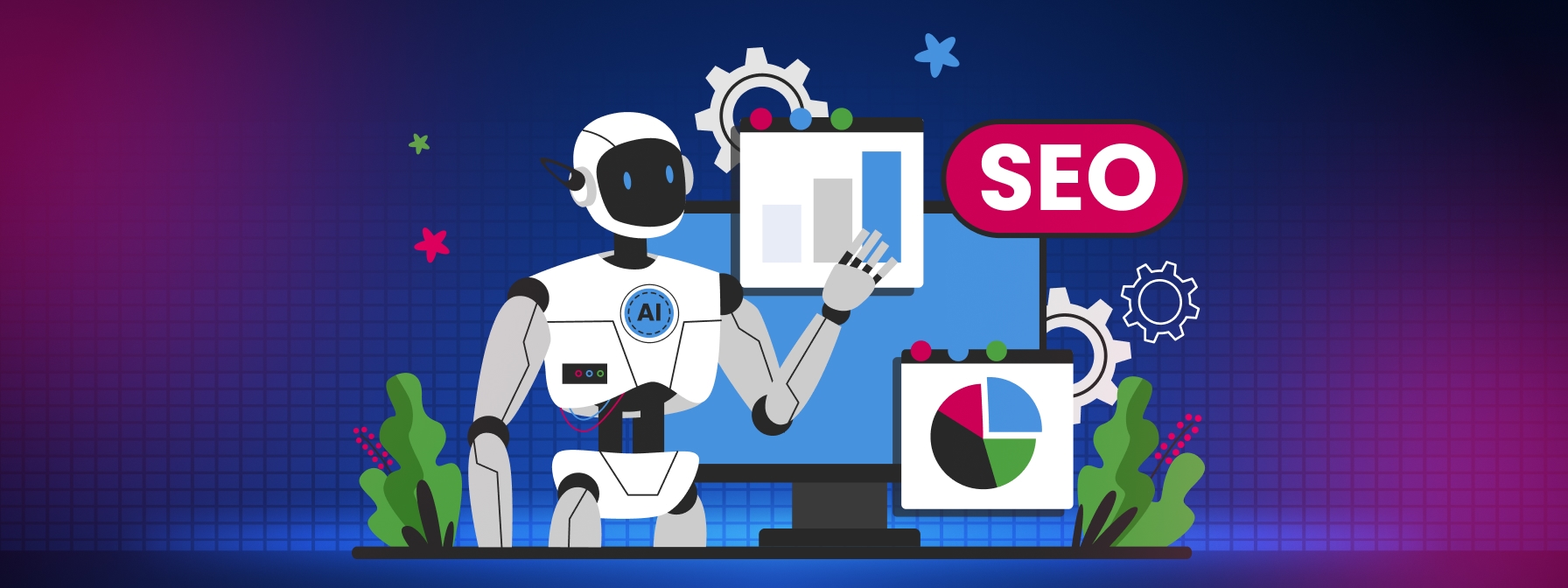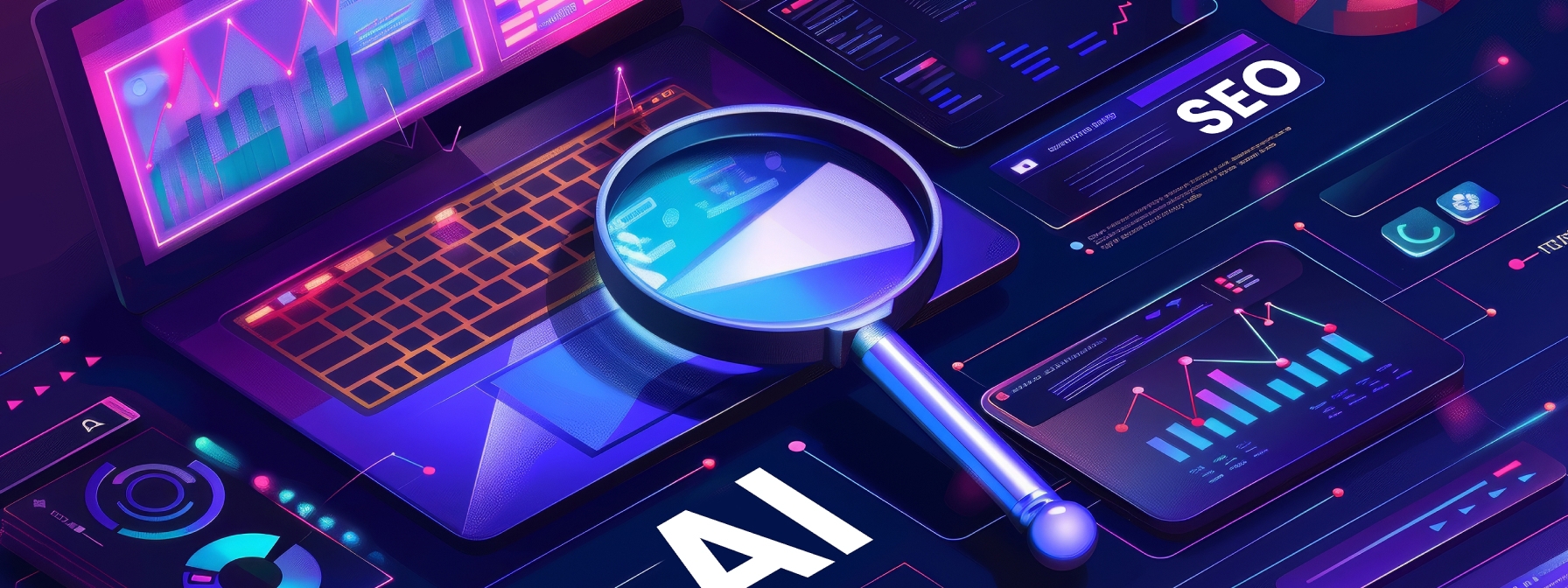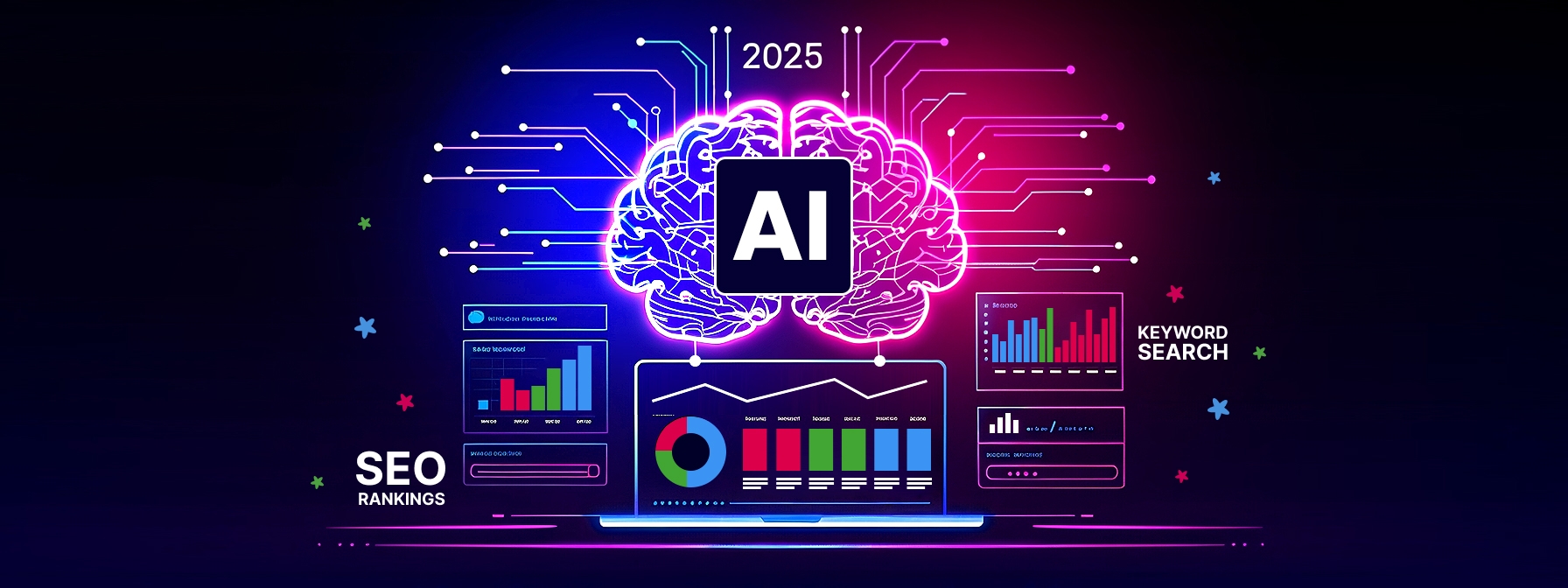
Table of Contents
AI SEO is Artificial Intelligence Search Engine Optimization. It involves utilizing AI, such as machine learning (ML), natural language processing (NLP), large language models (LLMs), and predictive analytics, to enhance SEO. AI SEO assists with keyword research, content creation, and technical SEO tasks, all of which are automated. This lets you do SEO faster and smarter.
Why AI SEO matters now:
- Search engines like Google AI Overviews, ChatGPT, Perplexity, and Claude give answers directly on the page. This causes more zero-click search, where users don’t click links.
- To show up in these kinds of searches, you need Answer Engine Optimization (AEO), Generative Engine Optimization (GEO), and entity SEO. Traditional SEO is not enough. SEO now needs to match how AI systems read and use content.
AI SEO Explained
AI SEO means using artificial intelligence search engine optimization methods to make content smarter. It uses machine learning (ML), natural language processing (NLP), and large language models (LLMs). Brands like ChatGPT, Perplexity, Claude, and tools like SurferSEO, Semrush, Ahrefs, Nightwatch, SearchAtlas, BrandWell, MarketMuse, Otterly.ai, and Alli AI help with AI SEO.
Core components:
- Keyword research automation: AI finds keywords faster using predictive keyword research and semantic keyword clustering.
- Content optimization: AI tools use topical authority building, embedding optimization, and LSI keyword inclusion for semantic relevance scoring.
- Technical SEO via AI: AI tools run automated SEO workflows, detect on-page AI suggestions, structure content with schema.org markup, fix issues like loading speed or mobile friendliness.
- Data analysis and performance prediction: AI offers conversion prediction, real-time rank tracking, and traffic analysis.
AI SEO vs traditional SEO:
Traditional SEO relies on keywords and backlinks. AI SEO adds AEO (Answer Engine Optimization) and GEO (Generative Engine Optimization) strategies. In AEO, content is crafted in conversational query optimization and Q&A snippet targeting style. GEO focuses on being cited by AI-driven search and generative engine optimization, so that AI systems like LLMs generate your content in their overviews. This approach also includes entity SEO, linking to concepts like Google AI Overviews, Knowledge Graph, RankBrain, BERT (Bidirectional Encoder Representations from Transformers), and MUM (Multitask Unified Model).
How AI SEO tools help:
- It thinks for you: Tools like SearchAtlas, Junia.ai, Nightwatch, SurferSEO, Semrush, Ahrefs, and BrandWell scan data, find content structuring for AI cues, and suggest content embeddings and semantic depth optimization.
- It writes with you: Tools help write in conversational snippet targeting style, insert semantic entities linking, apply schema markup, use proper headings, and include FAQ structure for AEO and GEO visibility.
- It matches search intent: AI helps align content with search intent modeling, context-aware SEO, and user intent alignment, so readers and AI systems find the content relevant.
- It spots technical issues: The AI tools run audits for technical SEO via AI, check page speed, structure, mobile support, and fix internal linking automation issues.
- It learns over time: AI records performance, tracks AI visibility metrics, uses real-time algorithm adaptation, helps grow your visibility in answer engine responses, improves brand mention in AI, AI overview visibility, and AI content personalization.
AI SEO is a mix of tasks: doing entity definition optimization, building content clusters, using token embedding vectors, and blending traditional SEO with a hybrid strategy, hybrid search visibility, and AI-friendly metadata. This makes content stronger for both users and AI systems.
How AI SEO Works
AI SEO uses machine learning (ML), natural language processing (NLP), and LLMs like ChatGPT, Claude, and Perplexity to help search engines find, understand, and use content better.
Data Ingestion
AI SEO tools collect lots of data. They gather keywords, analyze search intent modeling, and scrape SERP feature analysis. They also perform log-file analysis and track AI visibility metrics to see how often content is cited by AI systems.
Semantic Modeling
AI tools use semantic embeddings and token embedding vectors. They group terms into topic clustering and semantic keyword clustering. They build entity definition optimization that connects concepts in your content with Google’s Knowledge Graph and entity SEO practices.
Output Automation
Using models like RankBrain, BERT, and MUM, AI SEO platforms generate automated SEO workflows, propose content structuring for AI, automate internal linking, and add schema.org markup. They also suggest how to optimize for zero-click search, Q&A snippet targeting, and featured snippet readiness.
How AI Systems Use Your Content
AI assistants like Google AI Overviews, ChatGPT, and Claude sample content from the web to answer questions directly without clicks. To appear, your content needs a clear structure, factual language, and should be well optimized.
Continuous Learning and Predictions
AI systems track performance, predict user behavior (conversion prediction), update ranking outcomes in real-time algorithm adaptation, and measure brand mention in AI or AI overview visibility. This helps build topical authority over time and improves AI content personalization.
Key Benefits of AI in SEO

Using AI SEO gives many important benefits for websites. It helps with speed, accuracy, and growth.
1. Speed and Efficiency
AI SEO tools automate keyword research automation, automated SEO workflows, content creation and optimization, and technical SEO via AI. This means you save time. You can do more work faster. It removes manual grunt work so you can focus on ideas and strategy.
2. Data‑Driven Insights
AI tools analyze large data sets with machine learning (ML) and predictive keyword research. They spot trends users might not see. This helps with semantic keyword clustering, better search intent modeling, and clear conversion prediction. This leads to stronger performance decisions.
3. Better Content Quality
AI SEO tools use NLP in SEO, topical cluster modelling, embedding optimization, and semantic relevance scoring. They give suggestions for content structuring for AI, add schema.org markup, and help target Q&A snippet targeting. This makes content entity SEO ready and useful for users and AI.
4. Personalization and Engagement
AI helps personalize content using AI content personalization, matching user intent and interests. This reduces bounce rate, increases dwell time optimization, and improves conversions. It adapts writing and suggestions for different readers.
5. Predictive Adaptation
AI SEO systems provide real-time rank tracking, real-time algorithm adaptation, and predict ranking shifts. This helps you stay ahead of algorithm changes such as RankBrain, BERT, and MUM. You can adjust before issues affect your site.
6. Technical SEO Made Simple
AI tools help fix problems fast. They automate technical SEO via AI, check for mobile speed, site structure, and internal linking issues. They suggest fixes for on-page AI suggestions, internal linking automation, and improvement in AI visibility metrics.
Common Challenges & Limitations
Even though AI SEO brings many strengths, it also has challenges and limitations. You must use AI tools carefully and not rely only on them.
1. Accuracy and Trustworthiness
AI can make mistakes or hallucinate content. It may produce false or misleading information, especially in sensitive topics. This is risky for AI overview visibility and entity SEO trust.
Also, bias can exist in AI models if the training data is of low quality. This hurts semantic relevance scoring, entity definition optimization, and fairness.
2. Lack of Real-Time Data
AI models often use old data. They can’t access current search volume, competition, or ranking signals. This limits predictive keyword research, real-time rank tracking, and conversion prediction.
3. Technical SEO Limits
AI tools may detect issues, but cannot fix complex tasks like rendering problems, canonical tags, or site architecture. Those still need human experts.
4. Over-Reliance on AI
Some people rely too much on AI-generated content. This can lead to bland or repetitive writing, less human oversight, and problems with content quality. Tools can’t replace human creativity, nuance, or context.
5. Ethical Concerns
Using AI SEO can cause ethical problems. For example, spammy content farms use AI just to generate clicks without quality. That harms reputation and trust. Papers warn about AI bias and transparency.
AI SEO also raises issues around transparency and explainability. People may not understand how outputs are generated, which erodes trust.
6. Need for Human Oversight
Effective SEO still needs human input. Experts must check AI results, add strategic insight, and ensure that content is ethical, accurate, and aligned with search intent modeling.
How to Implement AI SEO
Follow these easy steps for AI SEO success:
Step 1: Audit Your Content
- Use tools like Semrush Copilot, SearchAtlas OTTO, or Alli AI to run automated SEO workflows and check your site.
- Identify content gaps, missing schema.org markup, slow pages, and poor internal linking automation.
Step 2: Keyword and Intent Mapping
- Use predictive keyword research in Semrush, SurferSEO, MarketMuse, or Perplexity to find key terms.
- Focus on search intent modeling and group terms using semantic keyword clustering and topic clustering.
Step 3: Entity and Context Setup
- Link your content to Google’s Knowledge Graph using entity definition optimization.
- Use content linking tools in Profound, Athena, or Scrunch AI to improve entity SEO presence.
Step 4: Write AI‑Friendly Content
- Use ChatGPT, ContentShake, Jasper AI, or Perplexity to craft articles in Q&A snippet targeting and conversational query optimization style for AEO and GEO.
- Apply LSI keyword inclusion, optimize semantic embeddings, and add schema markup to content.
Step 5: Ensure Technical Quality
- Run technical SEO via AI with Ahrefs, Alli AI, or MarketMuse to fix page speed, mobile issues, titles, descriptions, and internal links.
- Monitor AI visibility metrics and check site structure for errors.
Step 6: Track Performance and Adapt
- Use tools like Semrush, SurferSEO, Profound, or Otterly.ai to track real-time rank tracking, conversion prediction, and brand mention in AI.
- Adjust content based on performance trends and real-time algorithm adaptation.
Step 7: Build Topical Authority
- Create topical cluster modelling content: use multiple articles connected by topic.
- Use tools like MarketMuse, SearchAtlas, and BrandWell to build topical authority, reinforce embedding optimization, and optimize for AI overview visibility.
Step 8: Combine Human Review
- Always review AI outputs with human editing. Use judgment to ensure facts are accurate, style is natural, and tone is trustworthy.
- Manage bias and perform ethical oversight to ensure the content aligns with conversation and fairness standards.
Future Trends & What’s Next

SEO is changing fast. AI SEO is growing into new ideas like GEO (Generative Engine Optimization), AEO, AIO, and even Quantum SEO. Let’s look at what comes next.
1. AI Overviews and Zero‑Click Search
Websites now face fewer clicks because search tools like Google AI Overviews, ChatGPT, Perplexity, and Claude give answers directly at the top of search results. Up to 40% of queries finish without clicking a link—this is called zero‑click search. To show up, content must match AEO and GEO guidelines.
2. Rise of AEO and GEO
Answer Engine Optimization (AEO) and Generative Engine Optimization (GEO) are key. They shape how AI chatbots answer questions using your content. More than 30 startups now focus on AEO, while GEO uses files like llms.txt and AI metadata to improve citation chances.
3. Quantum SEO Emerges
Quantum SEO is a new idea by ThatWare. It uses ideas from quantum computers—like superposition and entanglement—to optimize keyword mapping, content forecasting, and clustering much faster than standard AI SEO. It promises predictive content optimization, semantic keyword mapping, and deep embedding optimization.
4. Personalization and Predictive Insights
AI tools will use more predictive models: conversion prediction, real‑time algorithm adaptation, and AI-aware topic clustering. Personalization will match reader behavior exactly, including tone and context, for better AI content personalization.
5. Focus on Ethics and Explainability
AI must become more transparent. Content strategies will include Explainable AI (XAI) so people know how decisions happen. Bias detection and ethical oversight will become important in entity SEO and semantic relevance scoring.
6. Continued Importance of E‑E‑A‑T
Even with AI tools, Experience, Expertise, Authoritativeness, and Trustworthiness (E‑E‑A‑T) remain vital. AI tools like MarketMuse, Clearscope, and SurferSEO now analyze E‑E‑A‑T signals and help structure content based on human credibility .
7. Multimodal and Visual Search Growth
Search is becoming more visual and spoken. Users now search with voice, images, and video. AI must read structured visual data. SEO will support voice assistant queries and image formats for better AI visibility.
FAQs
Q1: What is the difference between AI SEO, AEO, and GEO?
AI SEO uses machine learning (ML), NLP, semantic keyword clustering, and predictive analytics to improve visibility.
AEO (Answer Engine Optimization) focuses on making content show up in AI answers like Google AI Overviews or ChatGPT.
GEO (Generative Engine Optimization) ensures your content is cited by AI systems. AEO shapes how content is answered. GEO shapes how content is referenced in zero‑click search.
Q2: Will AI replace human-generated content?
No. AI tools like ChatGPT, Jasper AI, and Perplexity help with automated SEO workflows and content drafts but lack human creativity, context, and emotional nuance. Human oversight ensures accuracy and authenticity.
Q3: How do I measure the ROI of AI SEO tools?
Use tools like Ahrefs, Semrush, SurferSEO, or Profound to track metrics such as real-time rank tracking, brand mention in AI, conversion prediction, and AI visibility metrics. These reports show how well your AI-optimized content is cited in AEO, GEO, and overall search performance.
Q4: Can small businesses leverage AI SEO effectively?
Yes, small businesses can definitely leverage AI SEO effectively. AI SEO tools support keyword research automation, semantic keyword clustering, technical SEO search, and local voice or AEO/GEO optimization, helping smaller teams compete smartly in search
Q5: Is AI-generated content bad for SEO?
No. Google says AI content isn’t automatically penalized. Quality matters most. If the content is helpful, original, and clear—AI-generated or human—it can rank well. Avoid spammy, low-quality text.
Q6: What risks should I avoid when using AI SEO?
- Accuracy: AI can hallucinate or make errors. Always fact‑check content.
- Bias: AI may reflect bias in data, hurting semantic relevance scoring and fairness.
- Explainability: Lack of transparency can erode trust. Use Explainable AI (XAI) and ethical oversight.
Q7: Do I still need traditional SEO?
Yes. AI SEO works best when combined with traditional SEO fundamentals like backlinks, on‑page optimization, and technical audits. Hybrid strategies using AEO and GEO plus traditional tactics offer the strongest results.


